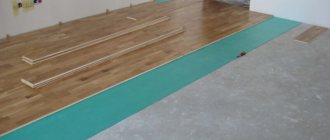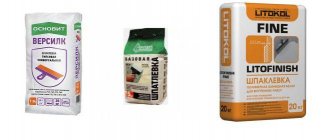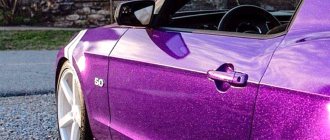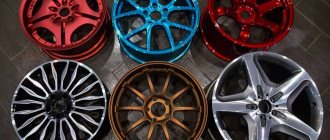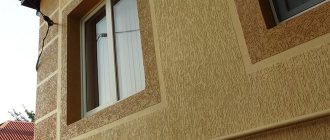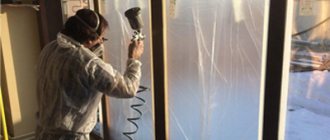We live in a world where almost everything is made of ferrous metal. In your homes it can be found as balcony railings, stairs, heating radiators, cold and hot water pipes, in private homes - various fence structures, gates with a wicket, roofing, bars on windows, all kinds of communication parts and much more. But everything has its limit, and even such a wear-resistant material as metal tends to become unusable. One of the reasons for this is corrosion. It almost completely destroys all metal structures during the entire period of operation, first of all, striking a blow to the appearance of the metal and its strength.
Advice! By finishing metal structures with metal paint, you can quickly prevent destruction.
Thanks to the application of a thin layer, metal structures will become immune to aggressive external factors, such as air temperature, precipitation and light man-made factors. It is worth noting that special components are added to any metal paint that, when combined with the metal surface, seem to restore it, getting rid of unwanted corrosion, as well as from oxidation that has already begun.
At the moment, there is a wide selection of paints, the most popular on the market are foreign brands Beckers, Meffert and domestic Novbytkhim and EMPILS.
Paint can be used to cover a wide variety of structures, from curly fences in the garden to a colossal roof. In modern conditions, a huge variety of materials will help you make the desired choice both in favor of the color scheme and in favor of your wallet. Everything depends on you. Please note that no matter what paint you choose, the main thing is to properly clean the surface to be treated. Alas, as in the case of metal, the paint is also not durable, so it will have to be renewed periodically.
How to choose the right paint
The wide variety of paints on the market today can be a little overwhelming when you personally approach this seemingly simple issue - like choosing paint for metal. First of all, you need to know that the effectiveness of the protective functions of a coating will come from its ability to resist corrosion. The main thing is that the applied layer retains its protective functions for many years.
Important! The cost of covering all subsequent layers will cost you much more than during the first treatment due to the high costs of finishing and preparatory work.
You shouldn’t skimp on quality by trying to win a couple of tens of rubles from the store on cheaper products. Therefore, buy products only from reputable manufacturers and do not skimp!
After all, as they say, the miser pays twice. Compare the cost of paint, its consumption per square meter and the number of layers required for application. These are the main factors by which you should compare products. Also, do not forget to ask the store consultants what types of surfaces the paint is intended for - external or internal. By choosing products from professional manufacturers, this task will be made easier for you, because on the banks they try to describe in as much detail as possible all the information important to the consumer.
Causes of wear and tear on chimneys
There are a large number of reasons that lead to wear and tear of the chimney.
For example:
- corrosion that occurs due to the impact of combustion products and flue gases on the masonry and other materials of the chimney;
- wind, humidity, precipitation, excessive heat;
- shortcomings in the design and construction of the pipe itself;
- unqualified intervention in the chimney system;
- when using the structure for other purposes, for example, when connecting artificial ventilation, the risk of destruction of the chimney increases;
- transition from one type of fuel to another;
- technologies, including “wet cleaning”, aimed at protecting nature;
- strong air injection from the boiler.
When using metal elements during construction, erosion may occur, which is also caused by unfavorable meteorological factors.
Heat-resistant paint for metal and rust
In the urban jungle, the main source of artificial heat is central heating. Based on the standards prescribed for batteries, the water inside them flows at a temperature of 45-70 degrees Celsius. If oil paints or alkyd enamels are used to protect them from corrosion, then the color of such pipes will quickly turn from white to yellow, the paint will crack, and over time, generally crumble. All this is due to insufficient heat resistance. According to GOST 1972-83, for heat-resistant paints, the heat resistance threshold must be at least 160 degrees Celsius.
Important! Never try to start applying paint to hot batteries, otherwise it will not harden.
Also keep in mind that all work must be done only in a warm room (but not too warm) so that the paint can dry. The approximate time required for this is from 2 to 4 weeks.
Such paints are very useful, because most of the metal elements that surround us are exposed to high temperatures. This means that the paint applied must be fully compatible with their performance characteristics. This includes fireplaces and stoves, dampers and grates for them, as well as everyone’s favorite grills and barbecues. Over time, all metal products quickly lose their aesthetic appearance, but the use of heat-resistant products keeps them in excellent condition for many years. For example, to protect chimneys and heating systems from corrosion, heat-resistant Tikkurila brand products with a threshold of 390 degrees Celsius are used. A brand called Meffert Silber Dufa has a similar scope of use. Its thin layer can withstand temperatures up to 490 degrees Celsius!
Step-by-step instructions for painting a chimney
For work you will need the following tools and materials:
- brushes or rollers for painting;
- metal brush for cleaning the surface;
- acetone or other degreasing liquid;
- primer;
- paint and varnish composition suitable for the chimney material.
For chimney painting to be effective, the following steps must be followed:
- Calculation of the area to be painted. This step is necessary to calculate the amount of materials needed.
- Cleaning up. It is necessary to remove from the base anything that can interfere with painting and also affect the quality of work: old paint, grease, dirt, etc.
- Primer. Needed for better adhesion of paint to the surface.
Painting is the final stage at which the paint coating is applied. If marking coloring is necessary, you should be guided by the following standards corresponding to paragraph 1 of Art. 51
Air Code of the Russian Federation:
- Pipes with a height of up to 100 m are painted with horizontal stripes from 0.5 m to 6 m of white and red colors (at least there must be 3 stripes).
- For structures over 100 m, the size of the strips should be from 1/7 to 1/21 of the entire height of the object. The outer stripes should be red.
Colors for painting chimneys.
The paint is applied in 2-3 layers so that the thickness is 40-60 microns. The consumption for 1 layer of coating is 120-150 g/m².
Pay attention to: Basic principles and secrets of painting fiberglass
Metal surfaces
Metal pipes are usually made of stainless steel, which is least susceptible to corrosion. However, any structure must be prepared before painting, otherwise painting on metal will not last long enough.
The work is as follows:
- Use a wire brush to remove dirt and old paint.
- Wash thoroughly and dry the base.
- Treat with a degreaser.
- Apply a corrosion inhibitor mixture.
- Cover with 2-3 layers of primer.
- The last stage is coloring. It is better to paint along the perimeter from top to bottom.
The main thing is the anti-corrosion coating, which increases the service life of the structure. Also important is the treatment of sealing seams - in these places the pipes are most susceptible to destruction.
Brick chimneys
Brick is used less frequently for construction. But such structures still exist.
Work algorithm:
- It is worth tightening the bolts on the connecting clamps.
- Remove traces of old stains.
- Wash off dirt.
- Restore the plaster if there is damage.
- Apply primer (2 layers or more).
- After drying, you can start painting. It is worth applying 2 layers of paint to the brick to make it stronger and brighter.
Ceramic pipes
The most heat-saving option for building chimneys is ceramic structures. They consist of a ceramic pipe, an insulating layer and metal or foam concrete layers.
The technology for painting a ceramic pipe depends on what the insulation layer is covered with:
- foam concrete should be painted in the same way as brick: clean, wash, restore damage (if any), apply primer and paint;
- the metal layer is processed according to the scheme for painting a metal pipe: cleaning, anti-corrosion composition, primer and painting itself.
Pay attention to: Painting the ceiling with water-based paint: choosing a roller and tips for use
Here you can choose a paint with a lower coefficient of resistance to high temperatures (since the insulating layer that is part of the structure reduces it).
What is rust
Each of us remembers from chemistry lessons at school that rust is the oxidation process of metal and products based on it. If metal products are stored in dry rooms, then they are unlikely to be subjected to this process, because rust appears only under the influence of oxygen combined with water or high humidity.
Important! In the case where rust does manage to penetrate the surface of the metal, it will increase endlessly even in the absence of the factors necessary for its appearance.
As it progresses, the metal will lose its functional abilities, namely strength and strength; you shouldn’t even think about its appearance. Only by clearing the object of existing corrosion 100% and covering it with a layer of paint can its further development be avoided.
Advice! Preventing a problem is much easier and cheaper than dealing with its consequences!
Steps to follow when processing metal products:
- The treatment area must first be cleaned with sandpaper or a grinder to remove all kinds of rust, sand and other contaminants.
- After cleaning, the surface should be degreased with your favorite cleaner or a handy product - a ten percent solution of acetic acid.
- Welding areas are treated exclusively with a brush.
- When working with large areas, rollers or small spray guns are used.
Popular brands
In order for heat-resistant paint for a stove, barbecue or fireplace to please the eye for a long time and perform all its protective functions, you should choose it correctly, taking into account all the features of the surface. Among the most popular manufacturers who have already established themselves in the finishing materials market are:
- Tikkurila, Thermal series (Finland) - the line includes paints that can withstand temperatures from 100 to 1000 degrees.
- Spectrum, Certa series (Russia) - produce finishing materials that can withstand temperatures up to 650 degrees. Heat-resistant paint is produced in cylinders, cans and buckets. The manufacturer offers a choice of 26 of the most popular shades, the most durable of which is black;
- Kudo (Russia) is a cheap analogue of the Certa series, since the materials are similar in their basic properties. Heat-resistant enamel from this manufacturer is presented in a palette of 20 colors;
- Hansa (Lithuania) - used for painting metal surfaces that are subject to heating up to 800 degrees. Available in enamel form;
- New tone (Ukraine) – suitable for processing metal parts of stoves, fireplaces, barbecues. The maximum permissible temperature is 800 degrees. Available in aerosol cans.
Thanks to the huge variety of finishing materials, it is now possible to decorate any surface that is exposed to heat in a bright and unusual way. Moreover, thermal paints will protect metal, stone or brick from the negative effects of external factors for a long time.
You may also be interested in:
Organosilicon paint - what is it?
Personal application
There is one important step in the metal processing process - as a preliminary stage of applying paint. It means that if you are working not with steel materials, but with ordinary “ferrous” metals, then it is important to remember that they need enhanced protection. To do this, use the following: after cleaning, the surface is coated with a special primer with anti-corrosion properties, and only then the paint itself is applied. As a result, your metal will be in no way inferior in durability to steel.
A special primer for expensive metals such as copper, brass, etc. can significantly increase adhesion in the paint layer. Choosing a primer for non-ferrous metals is not difficult; all you need to do is carefully read the information on the label.
How to remove old paint from metal
If you decide to update metal structures with new paint, you should know that first you need to get rid of the old one. How to remove the previous paint? Everything is very simple. There are three most common methods for removing old paint:
- burning.
This method involves using a heating pad or other high-temperature element that can heat the old paint to a liquid state and burn it off. Important! This method is not suitable for sheet metal. - manually, using a brush or sandpaper. Take the sanding element in your hands and go ahead, in half an hour there will be no trace left of the old paint;
- using chemical reagents. This is a more advanced, but also poisonous method. It should be done only with special gloves and a mask. Its essence is to dissolve paint using various cleaners and solvents.

